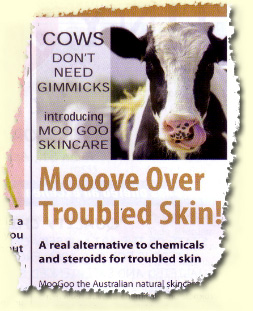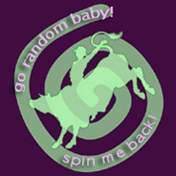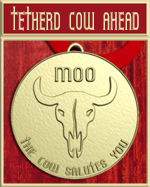Sun 26 Feb 2012
Cows Don’t Need Gimmicks!
Posted by anaglyph under Cow Matters, Daft Advertising, Hmmm..., Skeptical Thinking
[20] Comments

Today’s interesting tidbit comes to you, dear readers, courtesy of Acowlyte Essence De La Grenouille who I’m sure will not mind being affectionately referred to as Froggy.
Froggy’s local news source carried this rather intriguing advertisement which promises the delights of an Australian skincare product called MooGoo, an unguent which, the makers say, is ‘adapted’ from a cream used on dairy cow’s udders ‘to keep them in good condition for milking’. For reasons which are not entirely clear, this gives it excellent credentials as an effective skin treatment for humans. ((This falls in the same category as the ‘Baby’s Bottom’ analogy. It’s an advertising ploy that works on the principle that if it’s kind to a baby’s bottom/cow’s tender udder, then it must be gentle on your skin!))
Apparently MooGoo is ‘an Australian phenomenon’. It’s not phenomenal enough to have reached my ears, but I guess I’m not really in the target market so maybe it’s not overly surprising that I’ve never even heard of it. The MooGoo makers like to wax lyrical about the product’s use of ‘natural’ ingredients. Here, let me quote from the text of the MooGoo advertisement in Froggy’s newspaper:
[MooGoo] is made from only natural ingredients including edible oils such as almond oil, olive oil, rice bran oil and lots of other skin repair ingredients…
Well, not really much news there if you know anything about skin creams. In essence, MooGoo is selling a compound based on vegetable oils rather than on the petroleum-derivative oils that some other skincare products use. ((Petroleum derivatives are essentially vegetable oils anyway, formed as they are from the compressed deposits of million-year-old plants. It’s all just carbon semantics in the end.)) Since there are about, oh, a BILLION skincare concoctions that use vegetable oils, the main selling point of MooGoo basically still comes down to the cow udder thing.
Of course, being the good researcher I am, I visited the MooGoo site. It’s pretty harmless as these things go. They make a big deal about how their product is ‘natural’ ((The use of the word ‘natural’ in relation to these kinds of products is banal and stupid, and a pox on our modern sensibilities. The definition of mineral oil that makes it ‘unnatural’ also renders evening primrose oil unnatural. They both ultimately come from plants, and are acquired through a mechanical process. In the same way that it’s not wise to drink a glass of mineral oil, it would be inadvisable to drink a glass of evening primrose oil. Likewise, a dab of evening primrose oil on your hand is likely to have about the same consequences as a dab of paraffin.)) and harp on rather a bit too much about their lack of gimmicks. I think they must own a dictionary that has a different definition of the word ‘gimmick’ to mine, because I’m not really all that sure what they mean when they say things like:
MooGoo does not use gimmick ingredients and marketing…
You can, perhaps, see my amusement here: using vegetable oil ingredients is no big thing for a skin lotion, so the main point of difference between MooGoo and other similar products is the marketing angle that this marvellous substance comes from a treatment for cow udders. Which is, by any account, a gimmick.
As part of the MooGoo ‘we’re completely natural’ pitch, the front page of the MooGoo site features a video which claims to show ‘how most moisturisers are made’. It’s light-hearted and funny, but when the pretty-but-amiably-goofy spokeswoman starts talking about the evil that is in products-that-are-not-MooGoo, it becomes deceitful.
She gives us a demonstration of how sorbolene, commonly used in a variety of cosmetics, is made from paraffin oil, water and an emulsifier. But, she warns us sternly:
Paraffin oil is actually a flammable petroleum oil. Let me demonstrate.
… and then sets fire to a wick saturated with paraffin, which burns obligingly.
You’ve gotta wonder how many people are aware that those nicely packaged creams are made from a flammable petroleum oil. I’m sure that if they did know, they wouldn’t be very comfortable putting this on their skin, let alone their baby’s.
You’ve gotta wonder how many people fall for the old ‘scare-them-with-hellfire’ ploy.
Ms MooGoo continues:
We aren’t saying this cream is dangerous…
Really? Then it’s a little perplexing as to the point of the fiery demonstration and the conjoined images of a burning wick and a naked baby that follow. The implication is, by any reckoning, that the stuff you find in ‘other’ skin care lotions is related to petrol and therefore ouchy burny. MooGoo, we learn, is made from much less threatening stuff – like sweet almond oil, evening primrose oil and olive squalane.
Let’s see now… would that be the same sweet almond oil that is not merely combustible, but poisonous and a highly dangerous eye irritant? Or the evening primrose oil which is, like most hydrocarbon-based substances, also combustible? Or perhaps the olive squalane which, aside from also being a flammable hydrocarbon, is a saturated analog of squalene, a biochemical precursor to steroids? Would you be comfortable putting these on your baby’s skin? If that’s not scary enough, MooGoo almost certainly contains DHMO (Dihydrogen monoxide) a substance which can be highly toxic to humans.
Did you see what I did there, Acowlytes? I selectively chose negative consequences of the substances concerned and presented them as the most important aspects of those substances. I mixed my argument with conflated associations and a little scary-sounding scientific language et voilà ! – a picture of MooGoo that makes it sound as daunting as the products it derides. In the same way that the MooGoo video is careful to not actually lie, nothing I wrote is untrue. It’s just couched in such a way as to give the reader a strong unfavourable image.
As these things go, MooGoo is a pretty harmless example of flim flam. I really have nothing against this kind of product. It probably works as well as anything else you could buy of this nature. What annoys me, though, is the way the makers of MooGoo claim to be different to (and superior to) the other products they compete with, but then go and use pretty much exactly the same hocus pocus as everyone else to sell it. The fact is that every single one of these kinds of ‘moisturizing’ products, be they derived from paraffin or olives or almonds or turtles, ((Oh yes…)) works on the exact same basic principle – putting oil in your skin. Aside from a thousand relatively trivial differences, the major thing that differentiates one from another is the hyperbole and sleight-of-hand that advertisers use to sell them.




Oh no which is from turtles?
It used to be quite commonly used, but now is found mostly in Asia.
Umm….. I fell for it. I bought some for a member of the royal family who was complaining of dry skin. He valued my gift so much he fed it to the royal hound, who now has very glossy fur. Well at least someone benefited.
Well, as I say, it’s not that this product is in any way undesirable – I’m sure it works fine. It’s just that being associated with cow’s udders doesn’t bestow any magical effects on it. I guess it must have tasted OK though…
Moo Goo gai pan?
Umm… I fell for it too but at least now my udders are soft and supple and will not spontaneously combust as they did before.
Money well spent.
We’ve had a product up here in the states for over 100 years called Bag Balm, which was also originally designed to soften cow’s udders. The difference, I suppose, is that Bag Balm is a liniment. It has an antiseptic (8-hydroxyquinoline sulfate, if you are keeping track), and a lanolin base.
It appears to have an amazing number of uses, it’s been to the north pole with Admiral Byrd. It’s used also to protect metals (such as allied weaponry during WWII). Because we all know that testimonials make a great product.
In all seriousness, though, it is actually a pretty good product for dealing with burns, scratches, cracked skin, dry skin, itchy skin, etc.
Oh, there are a billion of ’em and everyone has their favourite. But like I said, it all comes down to one thing: oil. When your skin is dry, it benefits from oil. Oil serves other purposes too: when your saddle is dry, it benefits from oil; when your axe is rusty, it benefits from oil. Goanna Oil; coconut oil; Oil of Ulay; linseed oil; olive oil; paraffin oil – all hydrocarbons with impurities that give them a point of difference. But essentially, oils is oils.
No Sol, oils aint oils.
Er, yes, I was of course riffing on that.
Indeed, oils are oils.
For some reason ‘Bag Balm’is not allowed for sale in Alberta, Canada. We have Badger Balm, Udder Butter, and one with castor oil in it.( I really hope they mean the castor bean and not the beavers anal gland!!!)
I really hope they mean the beaver’s anal gland.
As someone who often has to write MSDS for personal care products, it’s always amazing to me how easily people get distracted. Companies say things like “it’s all natural” or “it’s organic”, as though that means anything. And they slam their competitors by saying “it contains chemicals!” But of course, many of those chemicals are plant derived. But the minute you include a chemical name that is polysyllabic and complicated, people freak out. Many skin care products especially like to sell themselves on the fact that they only contain “essential oils”, although many essential oils are allergens and can cause dermatitis after repeated use. But let’s not let facts get in the way of good fear-mongering. That said, I’m kind of disgusted by emu oil.
I always get kinda peeved at things that claim to restore ‘natural’ whatever (balances, hydration levels, hormones, get your natural skin back, etc). I mean, is it natural if you have to take a pill to achieve it? Wouldn’t what you already have be ‘natural?’ I realize that they are just using the world ‘natural’ as a euphemism for ‘better’ or ‘cleaner’ or ‘superior,’ but it irks me that people don’t get it like that. It almost seems deceptive.
And organic also is a gimmick. I mean, do the competitors of ‘organic’ products really contain no carbon? If they do, can you really call them inorganic (which is what the adverts are doing, yes?)?
The natural/organic scenario comes under Rules #4 & #5 in my post 10 Quick Rules for Spotting Hogwash. It’s one of those tricks that advertisers snapped up really quickly back in the 1970s when people started becoming informed about the kinds of things that were in their foods (and other products). Ultimately, it all comes down to a mistrust in science, and a misplaced trust that things that are not interfered with by humans are in some way superior.
Science has, unfortunately, become the whipping boy for a situation that has existed for millennia. Humans have long had a penchant for adding ‘special’ ingredients to their food and cosmetic products and the pedigree of those ‘additives’ has often been decidedly shady, if not downright dangerous. There was nothing to demonize with the practice, though, other than the mores of corrupt entrepreneurs. When science became a burgeoning field of business in the mid to late 19th C, it also became a bogeyman (embodied forever in fiction in Mary Shelley’s Frankenstein) and misdeeds and corruption that should have been laid at the feet of greedy and unethical people became attributed instead to a way of thinking.
Advertisers love this situation, because it is simple: things made by people in lab coats are BAD, and things made by Mother Nature are GOOD! (of course, the bespectacled researchers in white coats can also lend authority when the purpose serves, so you can see that advertisers play both sides of the field quite happily).
Oh, and when you say It almost seems deceptive acce245, there is no ‘almost’. It is deceptive. The intention is to make the consumer think something other than what is true. That is deception. The MooGoo people are intending to make you think that the products in other products will burn your skin, despite their protestations to the contrary. Otherwise, why even bring it up? Why stage a demonstration that shows you something burning, if not to imply that it is dangerous. When they say in the video ‘We don’t mean to say these things are dangerous’, they are simply being duplicitous (We’ll show you some highly impressive images – a burning wick and a naked baby – and then we’ll distance ourselves from it with a few words. Ha. Now there is deceit!)
I meant that ‘almost’ from the other direction, as in “it’s so terribly blatant that deceptive is a step up from what’s going on here.” Deception has to be subtle, in my opinion, and this is not. That’s all I meant. We share the same opinion here.
Also, the 1970s are well before my time, so I don’t know the whole ‘organic’ backstory. I’ve just always thought the idea was kinda bunk in the first place (I mean, really, ‘organic’ is the only choice most of the people who shop for it are probably ever going to make consciously to ‘better’ themselves. Why not let natural selection take its course, let them squander their monies, and then the ‘stronger’ people who had to survive the ‘bad’ stuff will ultimately win out eventually, and with the dying of the last organic hipster also dies the ‘organic’ label…). I mean, sure, it’s probably better to have fewer pesticides and whatnot in our foods, but to call chicken inorganic (or rather, whatever the opposite of organic is in this context.. evil anti-hippy food?) just because it contains a growth hormone seems rather dumb. If people don’t know their food is ‘safe’ or ‘healthy’ in the absence of a little sticker, or perhaps a person, telling them so, then perhaps that person should not be shopping, and should eat their friggin’ food.
Then again, now there are people who want to know the gender of the meat they are eating, because it makes some difference or something… Must be the new-age ‘organic.’